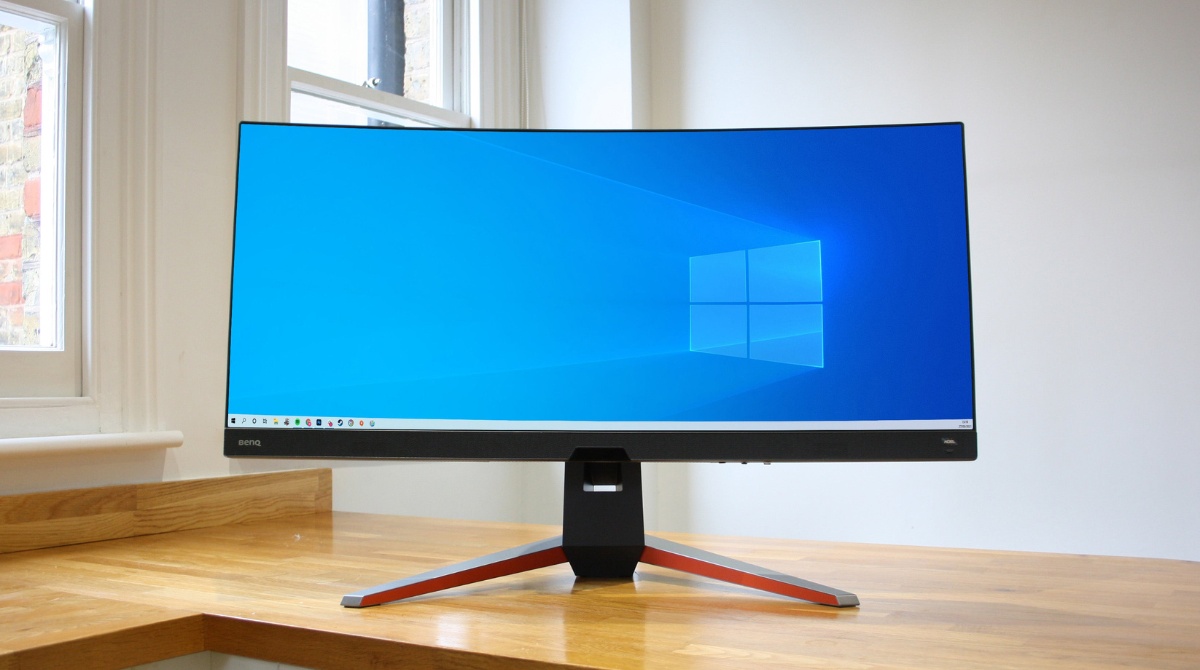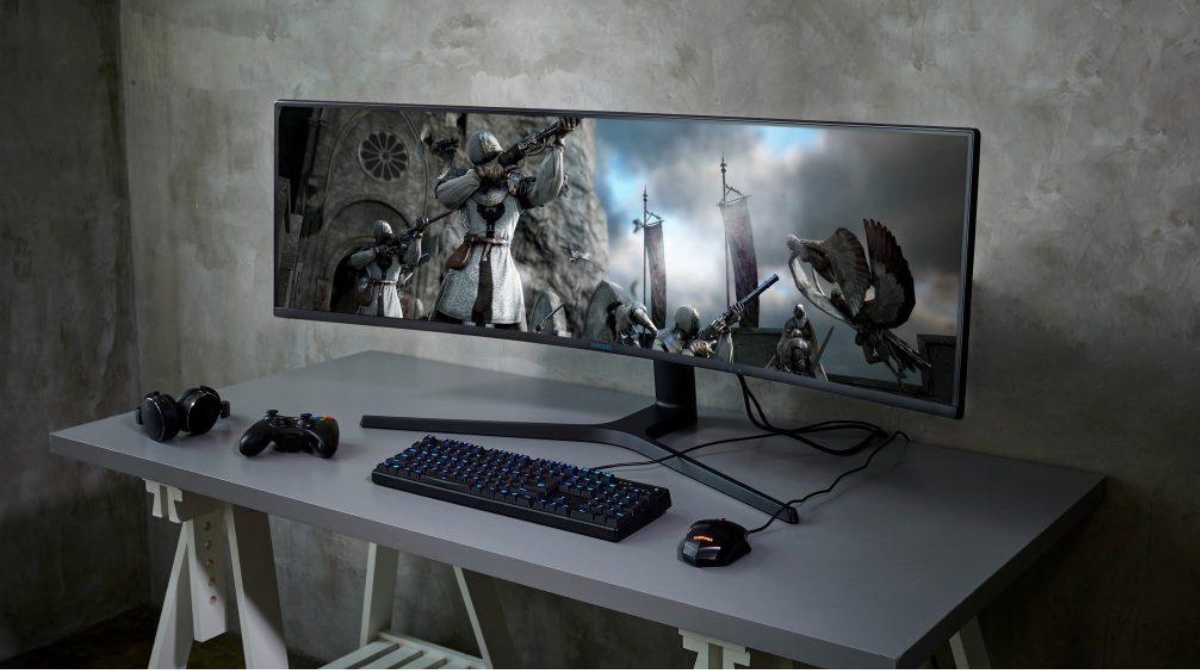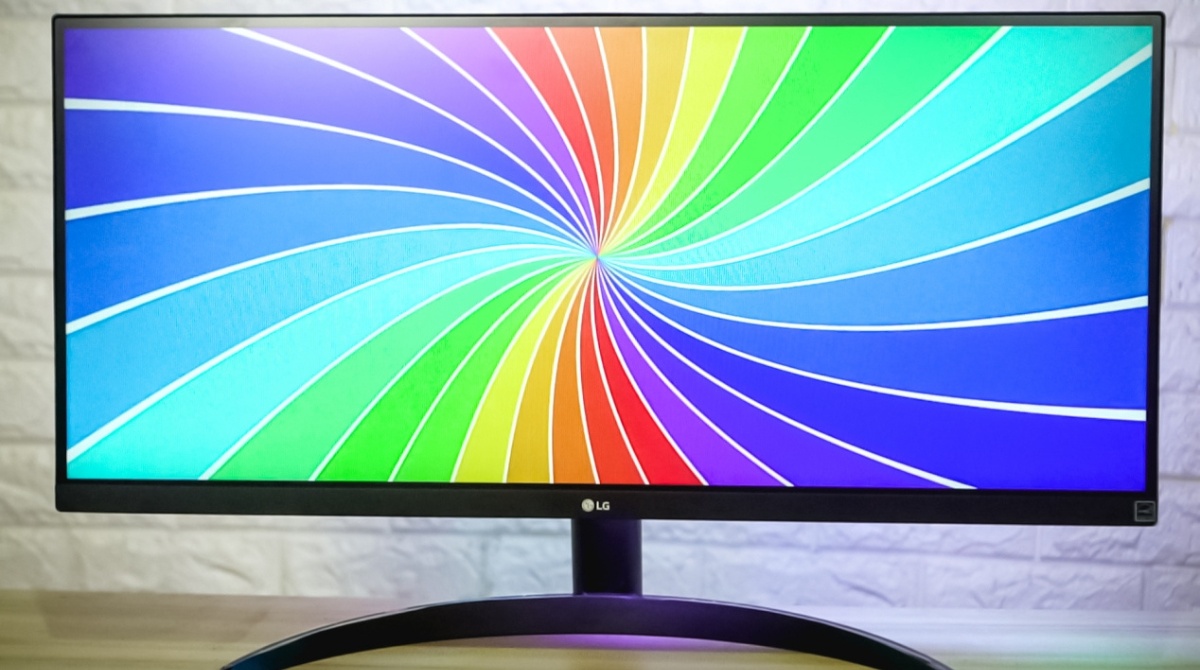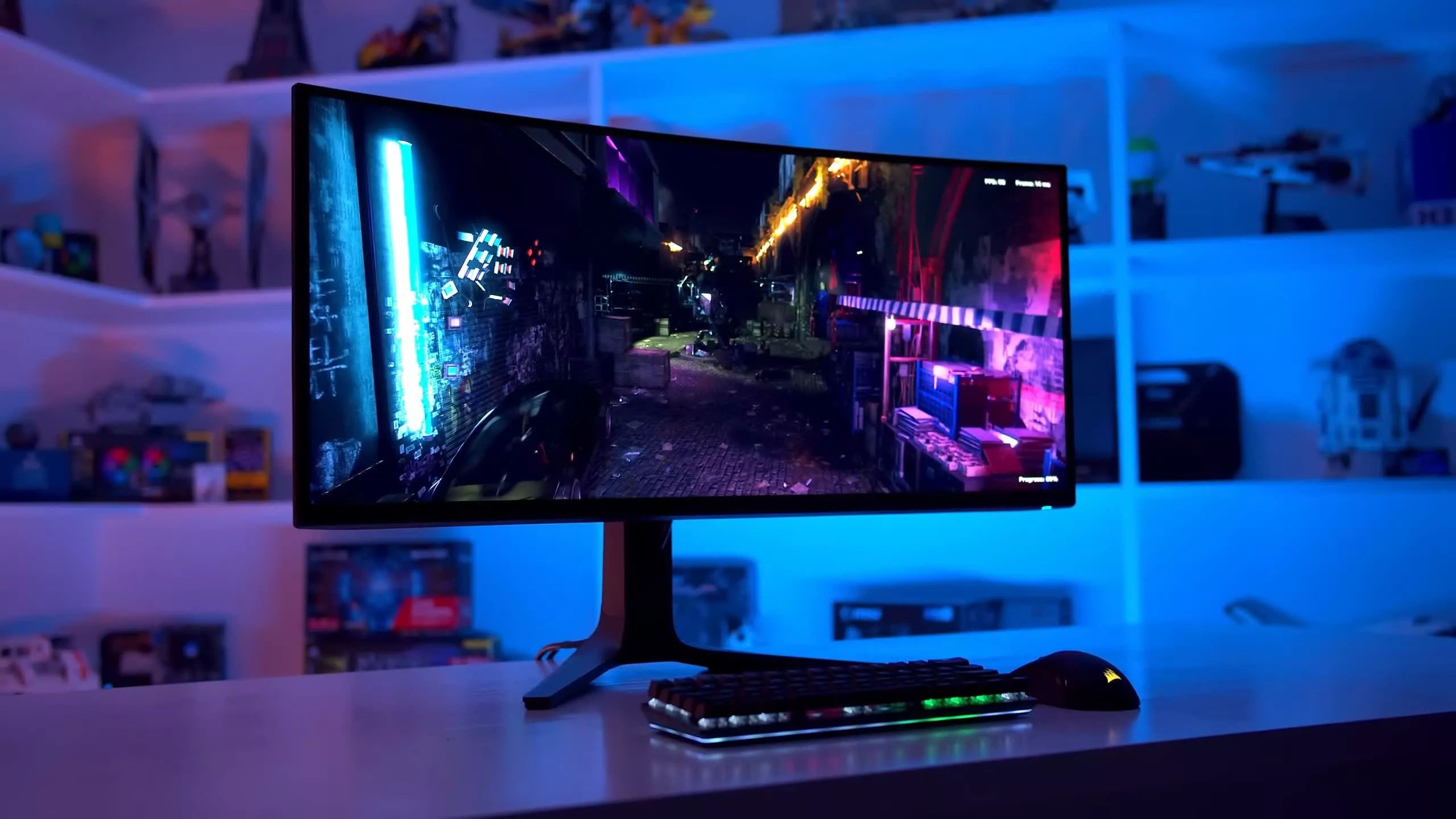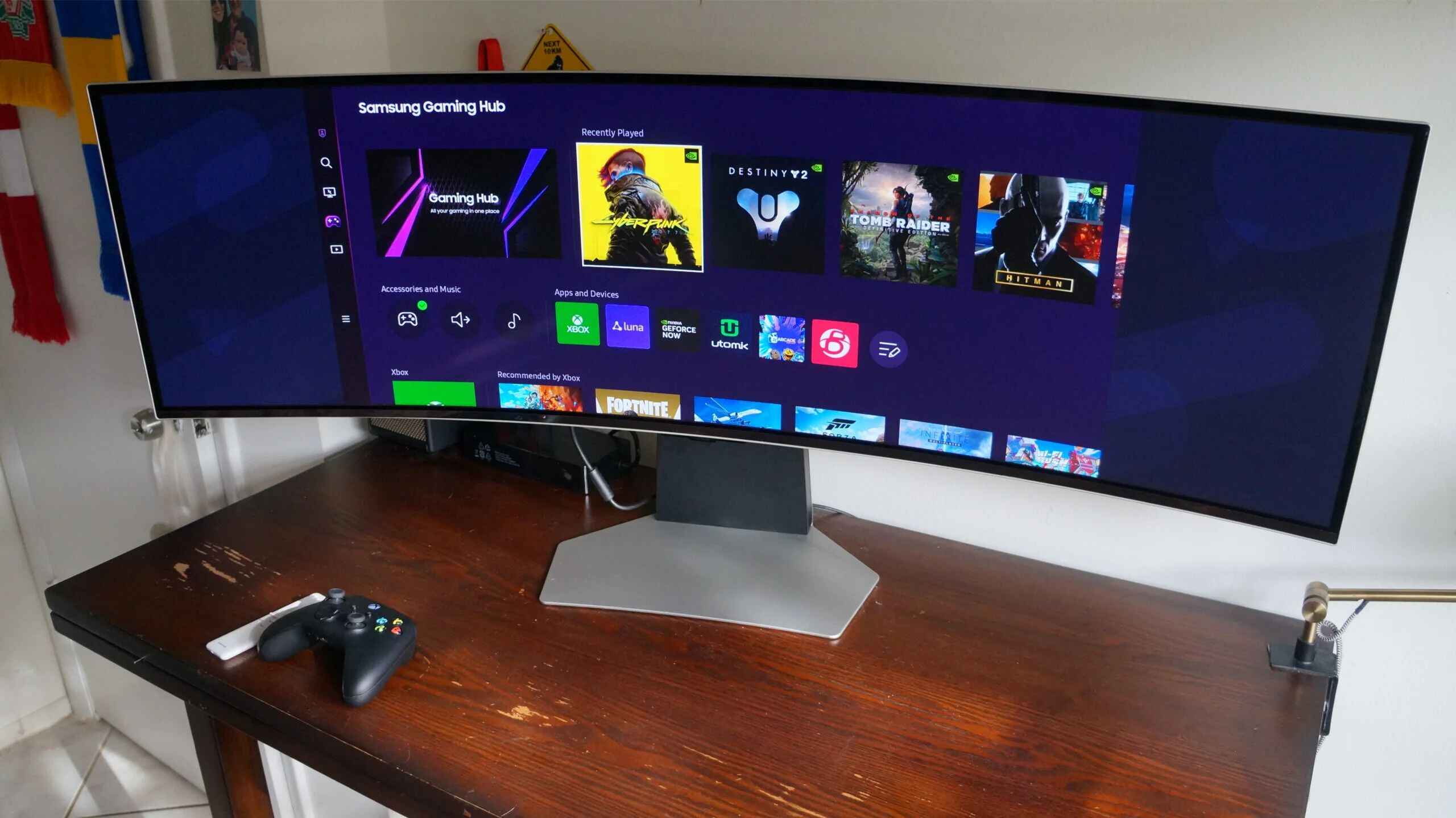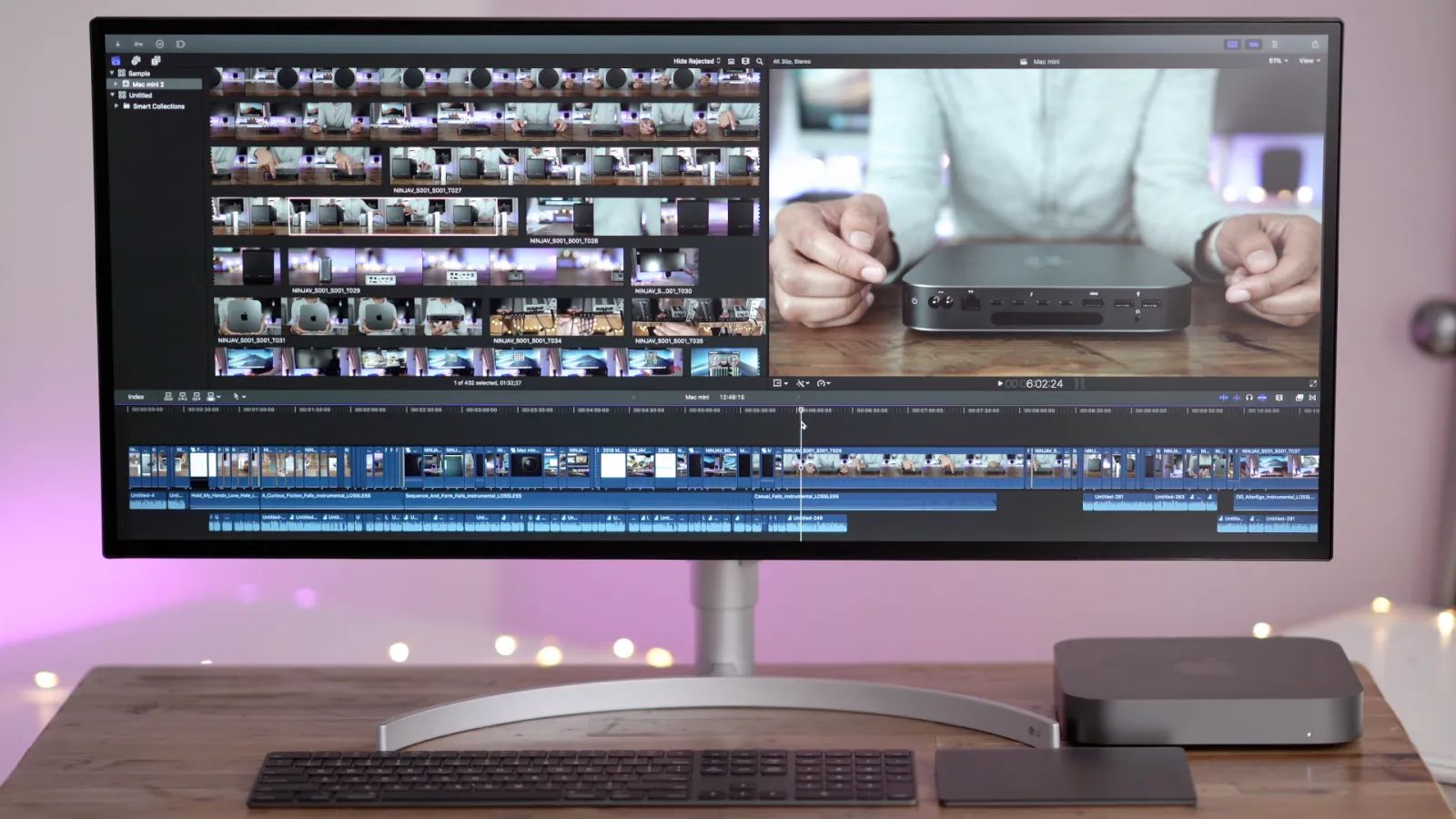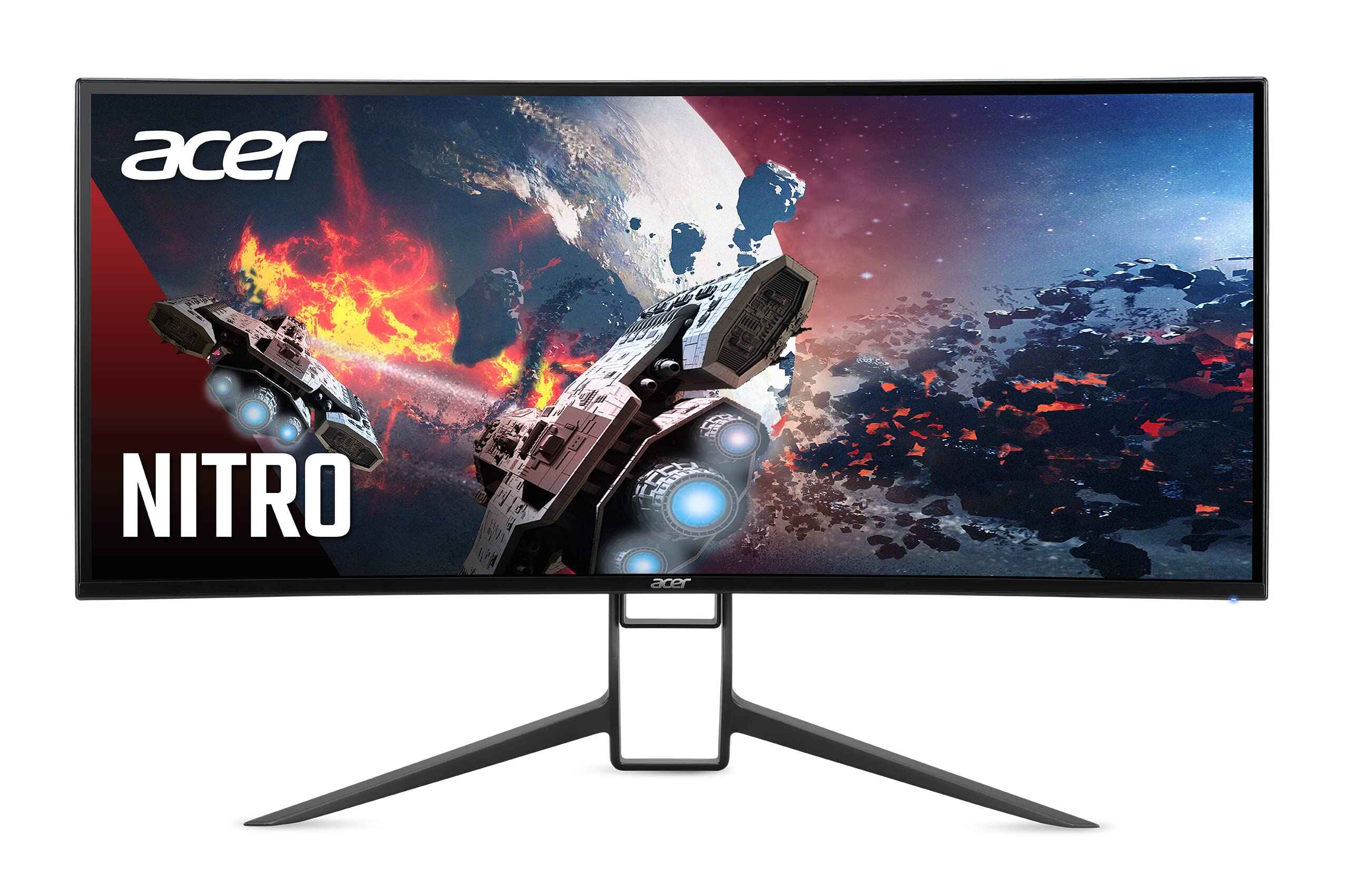Introduction
Welcome to the world of ultrawide monitors! If you’re in the market for a new monitor, you may have come across the term “ultrawide” and wondered what it’s all about. Well, you’re in the right place! In this article, we’ll delve into the world of ultrawide monitors, exploring their benefits, factors to consider when choosing one, and popular brands and models to help you make an informed decision.
Ultrawide monitors are a game-changer when it comes to screen real estate. Unlike traditional monitors with a 16:9 aspect ratio, ultrawide monitors boast an aspect ratio of 21:9 or wider, providing you with a wider and more immersive viewing experience. Whether you’re a creative professional, a multitasker, or a gamer, an ultrawide monitor can greatly enhance your productivity and enjoyment.
One of the main benefits of an ultrawide monitor is the increased screen space. With the wider aspect ratio, you can have multiple windows open side by side, eliminating the need to constantly switch between applications. This is particularly useful for tasks such as graphic design, video editing, and data analysis, where having multiple windows visible at once can significantly improve workflow efficiency.
In addition to the increased screen space, ultrawide monitors also offer superior multitasking capabilities. The wide aspect ratio allows you to easily split the screen into multiple sections, allowing you to work on multiple projects simultaneously or have your work-related tasks and personal entertainment options visible at the same time.
Moreover, ultrawide monitors have become increasingly popular among gamers. The wider field of view enhances the gaming experience, providing a more immersive and cinematic feel. You’ll be able to see more of the game environment, giving you a competitive edge and an enhanced sense of realism. Many ultrawide monitors also support advanced gaming features, such as high refresh rates, quick response times, and adaptive sync technologies, ensuring smooth and fluid gameplay.
Now that you understand the benefits of ultrawide monitors, let’s dive deeper into the factors you should consider when choosing one. From resolutions and display technologies to gaming features and connectivity options, we’ll cover everything you need to know to find the perfect ultrawide monitor for your needs. So buckle up and get ready for a visual feast!
The Benefits of Ultrawide Monitors
Ultrawide monitors offer a wide range of benefits that set them apart from traditional displays. Here are some key advantages that make them a game-changer:
- Enhanced Productivity: The wider aspect ratio of ultrawide monitors provides you with more screen real estate, allowing you to have multiple applications and windows open side by side. This makes multitasking easier and more efficient, whether you’re working on a complex project or managing multiple tasks simultaneously.
- Immersive Viewing Experience: With an ultrawide monitor, you can enjoy a more immersive viewing experience. The wider aspect ratio fills up your peripheral vision, making you feel more engaged with the content on the screen. Whether you’re watching movies, gaming, or editing photos and videos, the extra width adds depth and immersion to your visual experience.
- Better Multitasking: Ultrawide monitors are perfect for professionals who need to juggle multiple tasks and applications. The wider screen space allows you to have multiple windows open side by side, eliminating the need to constantly switch between tabs or applications. This can significantly improve productivity and efficiency, particularly in fields like graphic design, video editing, programming, and data analysis.
- Seamless Gaming Experience: Gamers can benefit greatly from ultrawide monitors. The wider field of view provides a more expansive and immersive gaming experience. You’ll be able to see more of the game environment, giving you a competitive edge and enhancing the overall gameplay experience. Furthermore, many ultrawide monitors come with advanced gaming features like high refresh rates, quick response times, and adaptive sync technologies, ensuring smooth and lag-free gameplay.
- Split-Screen Capabilities: Ultrawide monitors often come with software or built-in features that allow you to split the screen into multiple sections. This enables you to easily organize and arrange your content, making it ideal for tasks that require comparing and referencing information side by side. Whether you’re working on a research project, analyzing data, or writing code, the split-screen functionality of an ultrawide monitor can enhance your workflow.
- Reduced Clutter: With an ultrawide monitor, you can declutter your workspace by eliminating the need for multiple monitors. Instead of dealing with multiple cables, stands, and bezels, an ultrawide display streamlines your setup and creates a clean and minimalist workspace. This not only improves aesthetics but also gives you more desk space to work with.
Overall, ultrawide monitors offer a host of benefits that can significantly enhance productivity, improve gaming experiences, and elevate your overall visual experience. With their wider aspect ratios, immersive viewing, and multitasking capabilities, they are a worthy investment for professionals, creatives, and gamers alike. So, if you’re looking to take your work or gaming setup to the next level, an ultrawide monitor is definitely worth considering.
Factors to Consider When Choosing an Ultrawide Monitor
As you dive into the world of ultrawide monitors, it’s important to consider several factors that can affect your overall experience and suitability for your specific needs. Here are some key factors to keep in mind:
- Size and Aspect Ratio: Ultrawide monitors come in a variety of sizes, typically ranging from 29 inches to 49 inches. Consider the size that will best fit your workspace and personal preferences. Additionally, pay attention to the aspect ratio, with 21:9 being the standard. However, some ultrawide monitors boast even wider ratios, providing an even more expansive view.
- Resolution: The resolution of the ultrawide monitor determines the level of detail and clarity in the displayed content. Common resolutions include Full HD (1920×1080), Quad HD (2560×1440), and Ultra HD (3840×2160). Higher resolutions offer sharper visuals but also require a more powerful graphics card to drive the monitor effectively.
- Refresh Rate and Response Time: If you’re a gamer or engage in fast-paced activities like video editing, consider a monitor with a high refresh rate (typically 144 Hz or above) for smooth and fluid motion. Also, look for a low response time (ideally 5ms or lower) to minimize motion blur and ghosting effects.
- Panel Technology: Ultrawide monitors use different panel technologies, each with its own strengths and weaknesses. In-plane switching (IPS) panels offer excellent color accuracy and wide viewing angles, making them ideal for content creators. Twisted nematic (TN) panels emphasize fast response times, making them popular among gamers. Vertical alignment (VA) panels strike a balance between the two, offering rich visuals and decent response times.
- Connectivity Options: Ensure that the ultrawide monitor has the necessary connectivity options to connect to your devices. Look for HDMI, DisplayPort, and USB ports to support different devices and peripherals. Additionally, consider monitors that support USB-C connectivity for a more versatile and streamlined setup.
- Ergonomics and Adjustability: Pay attention to the monitor’s ergonomics and adjustability features. Look for height adjustment, tilt, swivel, and rotation options to find a comfortable viewing position. Additionally, consider monitors with VESA mounting compatibility if you prefer to use monitor arms or stands for a more customized setup.
- Additional Features: Take note of any additional features that may enhance your experience. These could include built-in speakers, USB hubs, blue light filters, and screen splitters. While not essential, these features can add convenience and functionality to your ultrawide monitor.
Considering these factors will help you narrow down your options and find the ideal ultrawide monitor that aligns with your specific needs, whether it’s for work, gaming, or multimedia consumption. Take your time to research and compare different models, reading reviews and user experiences to make an informed decision. By doing so, you’ll be well on your way to enjoying the benefits of an ultrawide monitor that perfectly suits your requirements.
Ultrawide Monitor Resolutions Explained
When choosing an ultrawide monitor, understanding the different resolutions available is essential. The resolution determines the number of pixels displayed on the screen, affecting the level of detail and clarity. Here are some common ultrawide monitor resolutions and their characteristics:
- Full HD (1920×1080): Full HD ultrawide monitors offer a good balance between affordability and visual quality. The 1080p resolution provides sharp images and decent pixel density on smaller screen sizes. However, on larger ultrawide monitors, the pixel density might be lower, resulting in a slightly less crisp image.
- Quad HD (2560×1440): Quad HD, also known as 2K, ultrawide monitors deliver increased screen real estate while maintaining a high level of detail. The higher resolution enhances productivity, image clarity, and overall visual experience. This resolution is popular among professionals who require precise image detail and multitasking capabilities.
- Ultra HD (3840×2160): Ultrawide monitors with Ultra HD resolution, also known as 4K, offer an incredibly detailed and immersive viewing experience. With four times the pixel density of Full HD, Ultra HD ultrawide monitors provide stunning visuals and sharpness, making them ideal for tasks that require high-definition images, such as video editing, graphic design, and content creation. However, keep in mind that driving an Ultra HD ultrawide monitor requires a powerful graphics card to handle the increased resolution.
- Super Ultra-Wide (3840×1600 and above): Super ultra-wide monitors take the resolution to the next level, offering even wider and more immersive screen space. With an aspect ratio of 32:9 or higher, these monitors cater to professionals who require an expansive workspace and want to eliminate the need for dual-monitor setups. These monitors are especially popular among content creators, video editors, and gamers who want a truly cinematic experience.
Choosing the right resolution for your ultrawide monitor depends on several factors, including your work requirements, budget, and personal preferences. If you primarily use your monitor for everyday tasks like web browsing, word processing, and multimedia consumption, Full HD or Quad HD resolutions should suffice. However, for professionals who work with high-resolution images, videos, or require an extensive workspace, Ultra HD and Super Ultra-Wide resolutions offer unparalleled visual quality and productivity benefits.
Remember that higher resolutions demand more powerful hardware to ensure smooth performance. Consider the capabilities of your computer and graphics card to ensure compatibility with the chosen resolution. It’s also worth noting that higher resolutions may have a greater impact on battery life for laptops and portable devices.
In summary, ultrawide monitors are available in various resolutions, each offering unique benefits in terms of image quality, detail, and work efficiency. Assess your needs, budget, and hardware capabilities to determine the optimal resolution that will enhance your productivity and visual experience. Whether you choose Full HD, Quad HD, Ultra HD, or even Super Ultra-Wide, an ultrawide monitor with the right resolution can elevate your workspace to new heights.
Refresh Rates and Response Times: What You Need to Know
When it comes to gaming and fast-paced activities, two important factors to consider in an ultrawide monitor are refresh rate and response time. These specifications play a crucial role in determining the smoothness and responsiveness of the displayed content. Let’s take a closer look at what you need to know about refresh rates and response times:
Refresh Rate: The refresh rate refers to the number of times per second that the monitor updates the displayed image. It is measured in hertz (Hz). A higher refresh rate provides smoother motion and reduces motion blur, resulting in a more enjoyable viewing experience. The standard refresh rate for most monitors is 60Hz, but ultrawide monitors often offer higher options, such as 75Hz, 100Hz, 120Hz, 144Hz, or even 240Hz. Keep in mind that to take advantage of a higher refresh rate, your graphics card needs to be capable of producing enough frames per second (FPS).
Response Time: The response time refers to how quickly pixels on the screen can change from one color to another. It is typically measured in milliseconds (ms). A lower response time ensures smoother transitions and reduces motion blur and ghosting, especially in fast-paced scenes. The standard response time for most monitors is around 5ms, but ultrawide monitors often offer response times as low as 1ms or even lower.
For gamers, a higher refresh rate and lower response time are crucial for a smooth and responsive gaming experience. A higher refresh rate allows for more frames per second to be displayed, reducing visual artifacts and providing a more fluid motion on the screen. Combined with a lower response time, fast-moving objects in games will appear sharper and more accurately, giving you a competitive edge in fast-paced gameplay.
It’s important to note that to take full advantage of a high refresh rate and low response time, your hardware needs to meet the requirements. Ensure that your graphics card can deliver enough FPS to match the desired refresh rate. Additionally, check the connectivity options of the monitor to verify if it supports the required refresh rate, such as HDMI 2.0 or DisplayPort 1.4. Otherwise, you may not be able to achieve the desired refresh rate.
While higher refresh rates and lower response times are desirable, they may come at a higher cost. Ultrawide monitors with higher refresh rates and lower response times often have a premium price tag. Consider your budget and gaming requirements to find the right balance between performance and affordability.
In summary, when choosing an ultrawide monitor, pay attention to the refresh rate and response time. For gamers and those engaging in fast-paced activities, a higher refresh rate and lower response time can significantly enhance the visual experience and gameplay. However, always consider the capabilities of your hardware and budget as you strive to find the right ultrawide monitor that meets your needs.
Ultrawide Monitor Display Technologies
Ultrawide monitors utilize different display technologies to deliver vibrant colors, wide viewing angles, and fast response times. Understanding these display technologies can help you make an informed decision when choosing an ultrawide monitor. Here are some common display technologies found in ultrawide monitors:
In-Plane Switching (IPS): IPS panels are known for their exceptional color accuracy and wide viewing angles. They offer vibrant and consistent colors, making them popular among professionals who work with graphics, photography, and video editing. With IPS technology, the colors remain true and vivid even when viewed from different angles, ensuring a consistent visual experience.
Twisted Nematic (TN): TN panels prioritize fast response times, making them suitable for gamers and fast-paced activities. These panels can achieve incredibly low response times, minimizing motion blur and ghosting effects. While TN panels may not provide the same level of color accuracy or wide viewing angles as IPS panels, they excel in delivering smooth and responsive visuals.
Vertical Alignment (VA): VA panels strike a balance between IPS and TN technologies. They offer deep blacks, high contrast ratios, and good color reproduction. VA panels typically have better response times than IPS panels but may not match the response times of TN panels. They are a popular choice for users who want a mix of vibrant colors and decent response times.
It’s important to note that the quality of display technologies can vary between manufacturers and models. While IPS panels are generally known for their color accuracy and wide viewing angles, not all IPS panels are created equal. Always check reviews and user experiences to ensure that the particular monitor you’re interested in offers the desired performance and visual quality.
Another factor to consider is the panel’s bit depth, which determines the number of colors the monitor can display. Most ultrawide monitors come with 8-bit panels, capable of displaying 16.7 million colors. However, some higher-end models feature 10-bit panels, offering a much broader range of colors and smoother gradients. If color accuracy is paramount to your work, consider an ultrawide monitor with a higher bit depth.
When choosing an ultrawide monitor, consider your specific needs and use cases. If accurate color reproduction and wide viewing angles are a priority, an IPS panel may be the best choice. For gamers and fast-action enthusiasts, a TN or VA panel with fast response times can ensure smooth visuals. Ultimately, it’s about finding the right balance between display technology, performance, and budget.
In summary, ultrawide monitors employ various display technologies such as IPS, TN, and VA panels to deliver stunning visuals. Each technology has its own strengths and weaknesses, so it’s important to choose the one that aligns with your specific requirements. Consider factors like color accuracy, viewing angles, response times, and bit depth to find the perfect ultrawide monitor that meets your needs.
Gaming Features to Look for in an Ultrawide Monitor
For gamers, the right features can enhance their gaming experience and provide a competitive edge. When choosing an ultrawide monitor for gaming, consider the following features:
- High Refresh Rate: A high refresh rate ensures smooth and fluid gameplay by reducing motion blur and providing more frames per second. Look for ultrawide monitors with refresh rates of 144Hz or above to ensure an immersive gaming experience.
- Quick Response Time: Low response times minimize motion blur and ghosting effects, making fast-paced games appear sharper and more responsive. Aim for an ultrawide monitor with a response time of 5ms or lower to enjoy smooth visuals during intense gameplay.
- Adaptive Sync Technologies: Adaptive sync technologies, such as AMD FreeSync and NVIDIA G-Sync, synchronize the monitor’s refresh rate with the graphics card’s frame rate. This eliminates screen tearing and stuttering, enhancing overall visual fluidity and providing a smoother gaming experience.
- Wide Color Gamut: A wide color gamut ensures vibrant and accurate colors, enriching the visual experience of games. Look for monitors with support for color gamuts such as sRGB, Adobe RGB, or DCI-P3 to enjoy captivating visuals.
- HDR (High Dynamic Range): HDR technology improves contrast and color accuracy, offering a wider range of bright and dark colors. Monitors with HDR support deliver more realistic and vivid imagery, adding depth and detail to games that support this feature.
- Low Input Lag: Input lag refers to the delay between the moment a command is given and the corresponding action on the screen. Opt for an ultrawide monitor with low input lag to ensure immediate response to your gaming inputs, providing a more accurate and responsive gameplay experience.
- Curved Screen: A curved ultrawide monitor provides a more immersive gaming experience, wrapping the display around your field of view. The curvature enhances depth perception, creating a wider and more immersive viewing experience that draws you into the game.
- Gaming-Specific Features: Look for additional features tailored for gaming, such as customizable gaming modes, crosshair overlays, and FPS counters. These features can enhance your gaming performance and provide useful information during gameplay.
- Connectivity and Ergonomics: Ensure the monitor has sufficient HDMI, DisplayPort, and USB ports to connect your gaming devices and peripherals. Additionally, consider the monitor’s adjustability features like height adjustment, tilt, and swivel to find a comfortable and ergonomic gaming setup.
By considering these gaming features, you can select an ultrawide monitor that provides an immersive, fluid, and visually striking gaming experience. Whether you’re playing fast-paced competitive games or exploring richly detailed open-world adventures, an ultrawide monitor with the right gaming features can elevate your gaming to the next level.
Key Connectivity Options for Ultrawide Monitors
When choosing an ultrawide monitor, it’s crucial to consider the available connectivity options to ensure compatibility with your devices and peripherals. Here are some key connectivity options to look for:
- HDMI: HDMI (High-Definition Multimedia Interface) is a widely used connection standard for transmitting high-quality audio and video signals. Most ultrawide monitors come with HDMI ports, allowing you to connect your laptop, gaming console, Blu-ray player, or other HDMI-enabled devices. Ensure that the ultrawide monitor supports the HDMI version required by your devices. Ideally, look for HDMI 2.0 or higher for optimal performance and compatibility.
- DisplayPort: DisplayPort is another popular connectivity option found on ultrawide monitors. It offers high-bandwidth data transmission capabilities, making it suitable for high-resolution displays and high-refresh-rate gaming. DisplayPort 1.2 or higher is recommended for the best experience with an ultrawide monitor. DisplayPort also supports daisy-chaining, allowing you to connect multiple monitors using a single cable.
- USB-C: USB-C connectivity is becoming increasingly common in ultrawide monitors. USB-C ports offer multiple functions, including video transmission, data transfer, and power delivery. A monitor with USB-C connectivity allows you to connect and charge compatible laptops and devices with a single cable, providing convenience and reducing cable clutter on your desk.
- USB Hub: Some ultrawide monitors feature built-in USB hubs, providing additional USB ports for connecting peripherals such as keyboards, mice, and external storage devices. This feature allows you to conveniently connect and disconnect multiple devices without having to reach behind your computer or use a separate USB hub.
- Audio: Check for audio connectivity options such as a headphone jack or built-in speakers if you plan to use the monitor’s audio output. A headphone jack provides a convenient way to connect your headphones or external speakers, while built-in speakers can be suitable for casual multimedia consumption.
- Other Connectivity Options: Depending on your specific needs, consider other connectivity options like DVI (Digital Visual Interface), VGA (Video Graphics Array), and Thunderbolt. While these options are less common on ultrawide monitors, they may be necessary if you have older devices or specific requirements that require these connections.
It’s important to consider the devices you plan to connect to your ultrawide monitor and ensure that the monitor has the necessary connectivity options to accommodate them. Pay attention to the specifications and compatibility requirements of your devices to ensure seamless connectivity and optimal performance.
Remember, having versatile connectivity options not only allows you to connect various devices but also future-proofs your monitor, making it compatible with upcoming upgrades or new devices you may acquire. So, evaluate your connectivity needs and choose an ultrawide monitor that offers the right combination of connectivity options to meet your requirements.
Design and Ergonomics: Finding the Perfect Fit
When choosing an ultrawide monitor, it’s not just about the specifications and features; the design and ergonomics also play a vital role in your overall comfort and user experience. Here are some factors to consider when evaluating the design and ergonomics of an ultrawide monitor:
- Size and Form Factor: Ultrawide monitors come in various sizes, typically ranging from 29 inches to 49 inches. Consider the available desk space and the optimal viewing distance. A larger monitor can provide a more immersive experience, but make sure it fits comfortably on your desk without obstructing your view or causing strain.
- Aspect Ratio and Curvature: Ultrawide monitors typically have an aspect ratio of 21:9 or wider, offering a panoramic view. Additionally, some monitors feature a curved screen, providing a more immersive visual experience by wrapping the display around your field of view. Consider your preferences and the tasks you’ll be performing to determine the best aspect ratio and curvature for your needs.
- Resolution and Pixel Density: Higher resolutions provide sharper images and more detailed visuals. However, it’s important to consider the pixel density as well. A higher resolution on a larger screen may result in smaller text and icons, impacting readability. For optimal viewing, ensure the resolution and pixel density strike a balance with your preferences and tasks.
- Adjustability: Look for an ultrawide monitor with adjustable features such as height adjustment, tilt, swivel, and pivot. Ergonomic adjustability allows you to find the most comfortable viewing position, reducing strain on your neck and eyes. Consider your preferred working or gaming posture and choose a monitor that offers the necessary adjustments to accommodate it.
- VESA Mount Compatibility: If you prefer a personalized or multi-monitor setup, ensure that the ultrawide monitor is VESA mount compatible. This allows you to use monitor arms or stands to achieve the perfect positioning and maximize your desk space.
- Bezel Size: The bezel size refers to the frame around the screen. A thinner bezel can provide a more immersive viewing experience, especially when using multiple monitors side by side. Consider whether a thin bezel is important to you, particularly if you plan to use multiple ultrawide monitors in a seamless setup.
- Cable Management: A clean and organized workspace enhances productivity. Look for monitors with built-in cable management features, such as cable routing holes or clips, to help keep your cables tidy and prevent them from cluttering your desk.
- Aesthetics: While aesthetics may be subjective, consider the overall design and appearance of the monitor. Choose a monitor that complements your workspace and personal style. Additionally, take into account any space limitations or design preferences you may have.
By considering these design and ergonomic factors, you can find an ultrawide monitor that not only delivers outstanding performance but also provides a comfortable and visually pleasing user experience. Take your time to evaluate your workspace, requirements, and personal preferences to select an ultrawide monitor that fits perfectly into your setup.
Popular Ultrawide Monitor Brands and Models
When it comes to ultrawide monitors, several brands have established a reputation for delivering quality and innovative products. Here are some popular brands and their notable ultrawide monitor models:
- LG: LG is a well-known brand in the ultrawide monitor market, offering a wide range of models. Their LG UltraGear lineup is popular among gamers, with models like the LG 34GN850-B and LG 38GN950-B featuring high refresh rates, low response times, and NVIDIA G-Sync compatibility. For professionals, the LG UltraWide series, including the LG 34WK95U-W and LG 38WN95C-W, offers stunning 5K or 4K resolutions, accurate colors, and excellent connectivity options.
- ASUS: ASUS is renowned for its gaming monitors, and their ultrawide offerings are no exception. The ASUS ROG Swift series, such as the ASUS ROG Swift PG35VQ and ASUS ROG Strix XG49VQ, feature high refresh rates, low response times, and impressive HDR capabilities, making them suitable for competitive gaming. ASUS also offers ultrawide monitors catered to professionals, like the ASUS ProArt series, which includes models like the ASUS ProArt PA34VC and ASUS ProArt PA34AC, with color accuracy and finely tuned visual settings for creative work.
- Samsung: Samsung offers a range of ultrawide monitors with high-quality displays and innovative features. The Samsung Odyssey G9 is a standout model with its massive 49-inch curved screen, high refresh rate, and HDR support, making it a favorite among gamers seeking an immersive experience. For productivity-focused users, the Samsung CJ791 and Samsung UR59C offer ultrawide displays with Thunderbolt 3 connectivity and excellent color accuracy.
- Acer: Acer’s Predator series stands out for gaming enthusiasts. The Acer Predator X34 and Acer Predator X35 feature fast refresh rates, low response times, and NVIDIA G-Sync support, providing a premium gaming experience. The Acer XR382CQK, part of the Acer XR series, caters to professionals with its wide color gamut and high resolution display.
- Dell: Dell is known for its reliable and feature-rich monitors. The Dell Alienware AW3418DW and Dell Alienware AW3821DW are popular among gamers, offering NVIDIA G-Sync compatibility, high refresh rates, and low response times. For professionals, the Dell UltraSharp series, such as the Dell UltraSharp U4919DW and Dell UltraSharp U3419W, provide wide color coverage and precise color calibration for tasks that require color accuracy.
These are just a few of the many brands and models available in the ultrawide monitor market. It’s important to thoroughly research and compare the features, performance, and user reviews of different models to find the one that best suits your specific needs and preferences.
Remember that popular brands are not the only options available, and there are other reputable manufacturers offering exceptional ultrawide monitors. Consider factors such as resolution, refresh rate, response time, color accuracy, connectivity options, and budget while exploring the wide range of ultrawide monitor brands and models available to ensure you find the perfect fit for your requirements.
Budget-Friendly Options without Sacrificing Quality
Investing in an ultrawide monitor doesn’t have to break the bank. There are budget-friendly options available that offer excellent performance and features without compromising on quality. Here are some budget-friendly ultrawide monitors worth considering:
- AOC CQ32G1: The AOC CQ32G1 is a 32-inch ultrawide monitor that offers a large screen and a 1440p resolution at an affordable price. With a 144Hz refresh rate and a 1ms response time, it delivers smooth gaming performance. It also supports AMD FreeSync, minimizing screen tearing and stuttering.
- ViewSonic VX2758-2KP-MHD: The ViewSonic VX2758-2KP-MHD is a 27-inch ultrawide monitor that features a 1440p resolution and a 144Hz refresh rate. It offers vibrant colors and wide viewing angles, thanks to its IPS panel. With AMD FreeSync support and a 1ms response time, it provides a smooth gaming experience at an affordable price.
- LG 34WL500-B: The LG 34WL500-B is a 34-inch ultrawide monitor that offers a 1080p resolution and a 75Hz refresh rate. It incorporates an IPS panel for accurate colors and wide viewing angles. While it may not have the highest specifications, it provides a budget-friendly option for users looking for an ultrawide display for work and multimedia consumption.
- BenQ EX3501R: The BenQ EX3501R is a 35-inch ultrawide monitor with a 1440p resolution and a 100Hz refresh rate. It features an HDR panel with good color accuracy and wide viewing angles. The monitor also offers AMD FreeSync support for smooth gameplay without tearing.
- MSI OPTIX MAG341CQ: The MSI OPTIX MAG341CQ is a 34-inch ultrawide monitor that offers a 1440p resolution and a 100Hz refresh rate. It features a curved VA panel that provides deep blacks and high contrast ratios. With AMD FreeSync support and a 1ms response time, it delivers a smooth gaming experience at an affordable price point.
These budget-friendly ultrawide monitors are just a few examples of what’s available in the market. While they may not have all the premium features or the highest resolutions, they still offer excellent performance and value for the price. It’s important to consider your specific needs and prioritize the features that are most important to you.
Before making a purchase, thoroughly research user reviews and consider the reputation of the manufacturer. This will help you gain insights from real users and ensure a reliable product. Remember that a lower price does not necessarily mean poor quality, and with careful research and consideration, you can find a budget-friendly ultrawide monitor that meets your needs without compromising on performance.
Conclusion
Choosing the right ultrawide monitor can greatly enhance your productivity, gaming experience, and overall visual enjoyment. By considering factors such as resolution, refresh rate, response time, display technologies, connectivity options, design, and budget, you can find the perfect ultrawide monitor that suits your specific needs and preferences.
Ultrawide monitors offer numerous benefits, including increased screen space for multitasking, an immersive viewing experience, and enhanced gaming capabilities. Whether you’re a professional looking for a versatile workspace, a gamer seeking a more immersive gaming experience, or someone who simply appreciates the beauty of a wide aspect ratio, an ultrawide monitor can be a game-changer.
As you explore different brands and models, keep in mind the reputation and reliability of manufacturers known for producing quality ultrawide monitors. LG, ASUS, Samsung, Acer, and Dell are just a few of the popular brands that offer a wide range of models catering to various needs and budgets.
While premium ultrawide monitors come with advanced features and higher price tags, there are also budget-friendly options available that deliver impressive performance without sacrificing quality. AOC, ViewSonic, LG, BenQ, and MSI offer budget-friendly models that still provide excellent value for the price.
Remember to thoroughly evaluate your specific requirements and consider the trade-offs between different features. Take into account the purpose of the monitor, whether it be gaming, work, content creation, or multimedia consumption. Be sure to read user reviews to gain insights into the real-world performance and user experiences.
Ultimately, finding the perfect ultrawide monitor is a matter of balancing your needs, preferences, and budget. With the wide variety of options available and the information you’ve gained from this article, you are well-equipped to make an informed decision and invest in an ultrawide monitor that will enhance your digital experience and visual enjoyment.







